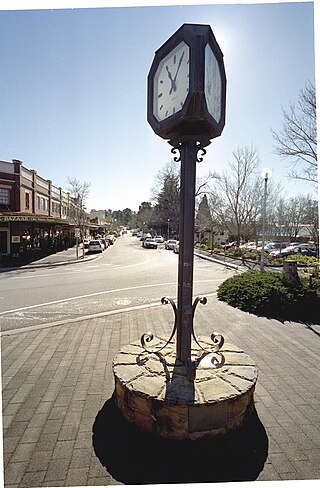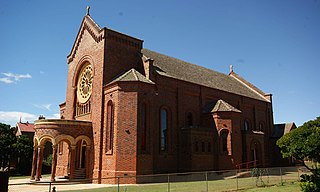
Wentworth is a small border town in the far south west of the state of New South Wales, Australia. It lies at the confluence of Australia's two most important rivers, the Darling and the Murray, the latter forming the border with the state of Victoria to the south. The border with the state of South Australia lies approximately 100 kilometres (62 mi) to the west. The town of Wentworth is in the local government area of the same name.

Wentworth Falls is a town in the Blue Mountains region of New South Wales, situated approximately 100 kilometres (62 mi) west of the Sydney central business district, and about 8 kilometres (5.0 mi) east of Katoomba, Australia on the Great Western Highway, with a Wentworth Falls railway station on the Main Western line. The town is at an elevation of 867 metres (2,844 ft) AHD. At the 2016 census, Wentworth Falls had a population of 6,076.

Austinmer railway station is a heritage-listed railway station located on the South Coast railway line in New South Wales, Australia. It serves the northern Wollongong suburb of Austinmer. It was added to the New South Wales State Heritage Register on 2 April 1999.

Thirroul railway station is a heritage-listed railway station on the South Coast railway line in New South Wales, Australia. It serves the northern Wollongong suburb of Thirroul. It was added to the New South Wales State Heritage Register on 2 April 1999.

The Wentworth Gaol is a heritage-listed former gaol and school building and now museum and old wares shop located at 112 Beverley Street, Wentworth, in the Wentworth Shire, New South Wales, Australia. It was designed by James Barnet and built from 1879 to 1881 by Whitcombe Brothers, Hay. It is also known as the Old Wentworth Gaol. The property is owned by Department of Primary Industries - Western Lands Commissioner, an agency of the Government of New South Wales. The property was added to the New South Wales State Heritage Register on 21 October 2016.

The Ebenezer Church is a heritage-listed Uniting church and cemetery and former schoolhouse located at Coromandel Road, Ebenezer, City of Hawkesbury, New South Wales, Australia. It was designed by Andrew Johnston and built from 1809 to 1823. It is now part of the Uniting Church in Australia, having been a Presbyterian church prior to amalgamation. The church was added to the New South Wales State Heritage Register on 2 April 1999.

Warwick East State School is a heritage-listed state school at 45 Fitzroy Street, Warwick, Southern Downs Region, Queensland, Australia. It was designed by Benjamin Joseph Backhouse and built from 1864 to 1912. It is also known as Warwick National School. It was added to the Queensland Heritage Register on 21 October 1992.

St John's Anglican Church, officially the Church of St John the Evangelist, is a heritage-listed Anglican church located at Darling Street, Wentworth, Wentworth Shire, New South Wales, Australia. It was designed by Reverend A. D. Soares and built in 1871. It is also known as St. John's Anglican Church and Rectory. The property is owned by the Anglican Parish of Wentworth. The church was added to the New South Wales State Heritage Register on 2 April 1999.

Catholic Church of Christ the King is a heritage-listed Catholic church building located at Macarthur Street, Taralga, Upper Lachlan Shire, New South Wales, Australia. It was designed by Sydney Smith of Ogg & Serpell and built from in 1934 by R. M. Bowcock. It is also known as Church of Christ the King. The property is owned by the Archdiocese of Canberra – Goulburn and was added to the New South Wales State Heritage Register on 30 April 2004.

St Mary's Anglican Church is a heritage-listed Anglican church and associated facilities located at 240 Birrell Street, Waverley, in the Waverley Municipality, Sydney, New South Wales, Australia. The church was designed by Edmund Blacket and built between 1863 and 1864. It is very well known and sought after as a place to be married and is popular for funerals. The building is also notable due its pipe organ, designed and built by August Gern. The property is used for ministry by the Anglican Parish of Bondi and Waverley, which is an amalgamation of two previous Parishes ; The first Rector of St Mary’s Waverley, Rev Stanley Mitchell, was a keen Evangelical and although he used traditional Anglican liturgy was “low church” like most of Sydney Diocese. However there has been a long history of more “High” Anglicanism and Anglo Catholic theological underpinnings. Since 2014, the church has returned to a strongly evangelical base while running a very strong traditional 1662 prayer book communion service every Sunday. It also has less traditional al services to accommodate more contemporary congregations.
Laurieton School of Arts is a heritage-listed school of arts, now used as a community hall and neighbourhood centre, at the corner of Laurie and Bold Streets, Laurieton, Port Macquarie-Hastings Council, New South Wales, Australia. It was designed by Sydney architect James H. Bolster and built from 1911 to 1912 by Taree contractor E. Bacon. The property is owned by Port Macquarie-Hastings Council. It was added to the New South Wales State Heritage Register on 2 April 1999.

St James' Anglican Church is a heritage-listed Anglican church precinct at 19 Tank Street, Morpeth, City of Maitland, New South Wales, Australia. The original design was attributed to Edward Charles Close, with later additions by Edmund Blacket and John Horbury Hunt and built from 1837 to 1875 by Edward Charles Close and James Sherwood. The precinct also includes the St. James' rectory and parish hall. The property is vested in the trustees of church property for the Diocese of Newcastle. It was added to the New South Wales State Heritage Register on 27 January 2017.

Grossmann House is a heritage-listed former residence and Maitland Girls' High School premises and now house museum at 71 Church Street, Maitland, City of Maitland, New South Wales, Australia. It was built from 1860 to 1862 by Isaac Beckett and Samuel Owen. It is also known as Grossman House. The property is owned by the National Trust of Australia (NSW), and is associated with the neighbouring Brough House, which is also owned by the National Trust. It was added to the New South Wales State Heritage Register on 1 March 2002.

Brough House is a heritage-listed former residence and premises for the Maitland Girls' High School and Maitland Art Gallery and now house museum at Church Street, Maitland, New South Wales, in the state's Hunter Region. It was built from 1860 to 1862 by Isaac Beckett and Samuel Owens. The property is owned by the National Trust of Australia (NSW). It is associated with neighbouring Grossmann House, which is also owned by the National Trust. It was added to the New South Wales State Heritage Register on 1 March 2002.

St Francis Xavier's Roman Catholic Church is a heritage-listed Catholic church at Hume Highway, Berrima, Wingecarribee Shire, New South Wales, Australia. It was designed by Augustus Pugin and built from 1849 to 1851 by William Munro. Originally known as St. Scholastica's Church, it is used by the Parish of St. Paul, administered by the Pauline Fathers, and located in the Diocese of Wollongong. It was added to the New South Wales State Heritage Register on 25 January 2008.

St John's Roman Catholic Church and Cemetery is a heritage-listed former school and now Roman Catholic church building located in George Street in Campbelltown. It was designed by John Joseph Therry and built from 1824 to 1841. It is also known as St Johns Roman Catholic Church and Cemetery (former), Saint Johns Roman Catholic Church and Old St John's Church. It was added to the New South Wales State Heritage Register on 2 April 1999. The current church, called St John the Evangelist Catholic Church was built in 1886 and is located at Cordeaux Street, Campbelltown in the City of Campbelltown local government area of New South Wales, Australia. The property is owned by Trustees of the Roman Catholic Church for the Diocese of Wollongong.

The Upper Castlereagh Public School is a heritage-listed former closed school building located at 312 Old Castlereagh Road in the western Sydney suburb of Castlereagh in the City of Penrith local government area of New South Wales, Australia. It was designed by George Allen Mansfield and built from 1878 to 1879 by James Evans. It is also known as Upper Castlereagh Public School and residence. The property is owned by New South Wales Minister for Community Services. It was added to the New South Wales State Heritage Register on 2 April 1999.

St John's Anglican Church and Macquarie Schoolhouse is a heritage-listed Anglican church building and church hall located at 43-43a Macquarie Road, Wilberforce, City of Hawkesbury, New South Wales, Australia. The church was designed by Edmund Blacket and built from 1819 to 1859 by James Atkinson, senior; and the schoolhouse was built by John Brabyn. The church is also known as the St. John's (Blacket) Church, while the hall is also known as the Macquarie Schoolhouse/Chapel and the Wilberforce Schoolhouse. It was added to the New South Wales State Heritage Register on 20 August 2010.

The Millers Point Post Office is a heritage-listed former post office and office building and now residence at 12 Kent Street, Millers Point, City of Sydney, New South Wales, Australia. It was designed by NSW Government Architect's Office under Walter Liberty Vernon. It was added to the New South Wales State Heritage Register on 23 June 2000.

St Peter's Anglican Church is a heritage-listed Anglican church and associated Sunday school, rectory, and cemetery at 384 Windsor Street, Richmond, City of Hawkesbury, New South Wales, Australia. It was designed by Francis Clarke and Edmund Blacket and built from 1836 to 1841 by James Atkinson (church). It is also known as St Peter's Anglican Church Group, St Peter's Church Group, Church, Rectory, Church Yard, Cemetery and Stables. It was added to the New South Wales State Heritage Register on 16 August 2019; and on the City of Hawkesbury local government heritage register, and listed on the New South Wales Heritage Database on 12 September 2012.





















